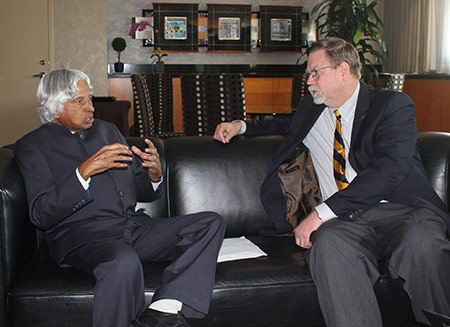The National Space Society (NSS) today announces a new space solar power international initiative. NSS endorses this initiative and will work to forge an international organization involving America, India and other nations to develop space solar power. This has the potential of solving humanity’s energy needs and greatly mitigating climate change.
The following is a joint statement of Dr. A. P. J. Abdul Kalam, Former President of the Republic of India and Mr. Mark Hopkins, Executive Committee Chairman, National Space Society.
Space Solar Power: Key to a Livable Planet Earth
Joint Statement of Dr. A. P. J. Abdul Kalam
Former President of the Republic of India
and
Mr. Mark Hopkins
Chairman of the Executive Committee, National Space Society
June 1, 2013
We, Dr. Kalam and Mr. Hopkins, have long shared humanity’s dream of all nations living together in prosperity and peace and moving forwards through global collaboration in space to meet the challenges that now face our Planet Earth. We are conscious that all nations have to strive to make our planet livable again, after centuries of devastation of its environment and ecosystems and rapid depletion of its precious mineral resources, including fossil fuels and fresh water.
Over these last three years many of our colleagues, in NSS and in India, have come together and made progress towards this international collaborative mission by sustained dialogue with mutual respect, understanding, and trust. It is essentially this process that has helped us to decide that the time has arrived for us to together attempt to give a direction and momentum to this movement to realize space solar power and its enabling technologies through international collaboration that can help rebuild our environmentally vulnerable planet.
Today, we begin working together in a well organized and well supported manner to realize such a 21st Century global collaboration; and together help to lay the structural foundation for an international collaboration to develop and deploy space solar power systems. We are aware that coalitions and collaborations work best if there is a shared mission and common goals, and effective leadership. We need to build strong, trusting relationships across nations through a participatory process with the active involvement of member nations and their institutions and organizations. We will work to develop an effective mission governance process and hope to evolve, jointly and together in international teams, clear operating procedures regarding decision-making, communications, and accountability. We shall be working together to develop a shared vision, to build strong relationships within the leadership team, and to rotate leadership roles.

Kalam and Hopkins discuss joint statement at the 2013 International Space Development Conference (ISDC).
Such a shared vision shall include specific mechanisms such as the Global Space Knowledge Platform, the International Virtual Laboratory, and the International Advisory Committee that Dr. Kalam has elaborated through discussion papers with Mr. Hopkins and his Address to the 2013 National Space Society’s International Space Development Conference (ISDC 2013). We hope our international collaborative mission will act as a catalyst for a livable planet which will promote prosperity and peaceful relations within and between nations.
We shall start our team building and mission structuring phase with core members from nations who we know are already networking and who are contributing to the dream of harvesting energy from space, including the US, India, Japan, and UK. We shall also invite, as observers, representatives in relevant domains of public policy, science and technology and management systems from other space faring nations like Russia, China, and other European nations. We shall engage in open and frequent communication with people who share our values and goals in governments and societies which are important to the success of this venture. We will help accomplish this through collaborative practices that are the true hallmark of effective global cooperation for a livable planet Earth. We shall have a clear plan of action to market the idea of a livable planet Earth through space solar power to G8 or G20 nations within a year.
Towards this end, we agree to start working together by jointly identifying the core members and observer members in the joint working mechanisms that Dr. Kalam has proposed. This shall be the direction of what we must accomplish in the coming months. We shall build upon the trusting relationships we have established and consolidated these last three years between NSS, Dr. Kalam, and others in India. We shall now strive to expand this relationship in an organized and well-structured manner towards an international collaborative mission to realize space solar power for all humanity.
For more information concerning the plan, see Dr. Kalam’s June 2, 2013 address to the leaders of the Indian aerospace community and “Global Space Solar Plan Unveiled,” Aviation Week, June 3, 2013.
About Dr. Abdul Kalam: Despite coming from a poor background, which required him to work at an early age to supplement his parents’ income, Dr. Kalam obtained degrees in Physics and Aeronautical Engineering. He was project director of India’s first indigenous satellite launch vehicle. Dr. Kalam was subsequently responsible for the evolution of ISRO’s (India’s equivalent of NASA) launch vehicle program. From 1992 to 1999, he was the Scientific Adviser to Defense Minister of India and Secretary, Department of Defense Research & Development. Dr. Kalam was President of India from 2002 to 2007. He is known for his work with students. His 79th birthday was recognized as “World Student’s Day” by the United Nations. According to a 2010 Readers Digest poll, he is one of the two most trusted men in India. Dr. Kalam has received numerous prestigious awards including the Bharat Ratna, India’s highest civilian honor, and the 2013 Wernher von Braun Memorial award from the National Space Society. He currently serves as the Chancellor of the Indian Institute of Space Technology, the leading institution for producing new engineers and scientists for India’s space program. Read more about Dr. Kalam at his website.


















